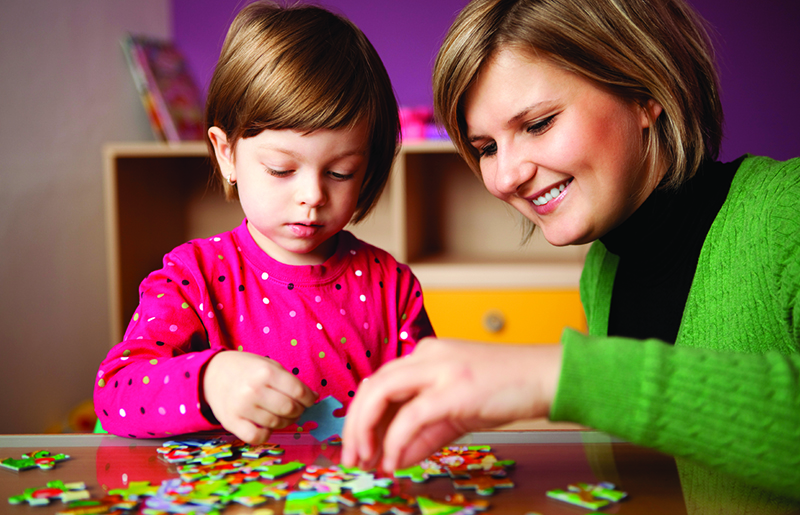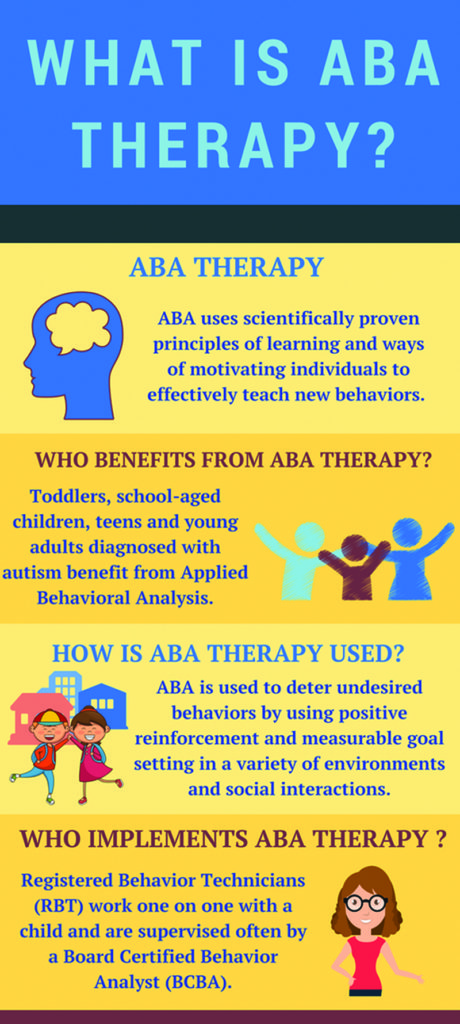
ABA is short for applied behavioral analysis, a type of therapy that focuses on improving specific behaviors such as social skills, communication, reading, academics, as well as adaptive learning skills, which include fine motor, hygiene, grooming, domestic capabilities, punctuality, job competence, and decreasing targeted behaviors.
ABA is effective for children and adults with autism, or psychological disorders. It has also been proven that consistent ABA can significantly improve behaviors and skills, and decrease the need for special services. It can also help control transitional challenges that can arise, minimizing or controlling the negative behaviors all together. It’s most successful when intensely applied for 20 hours a week or more.
ABA is based on theories which state that desired behavior can be taught through a system of rewards and consequences. It can be thought of as applying behavioral principals with behavioral goals and carefully measuring the results.

While the idea of using reward and consequences to teach behavior is probably as old as human civilization, the idea of carefully applying rewards and consequences to achieve specific measurable goals is a relatively new concept. The idea is that autism is a set of behavioral symptoms, which can be modified or extinguished. Most of the time ABA is intended to extinguish undesirable behaviors and teach desired behaviors and skills, for example; it may be used to reduce outburst and tantrums, or to teach a child to sit quietly use words to make requests, or wait their turn when playing a game. ABA can also teach simple and complex skills, for example: it can be used to reward a child for sharing a toy with a friend, or putting their plate in the sink after dinner. The goal of any ABA program is to help each person become more independent and successful.
Its not one-size-fits-all, each program is written to meet the needs of each unique person. Treatment goals are written based on the age and ability level of the person and can be provided in many different locations—home, school, clinic, and out in the community. ABA teaches skills that are useful in everyday life. It can be done one-on-one or in a group setting.
A Board-Certified Behavior Analyst (BCBA) oversees the program. Each analyst customizes the program to each individual’s skills, needs, interests, preferences, and family situation. The BCBA will evaluate the individual and come up with treatment goals and family goals and how to implement them. Then the trained therapist, referred to as either a behavioral therapist, para, or behavior tech, supervised by the BCBA, works directly with the individual to practice skills and work toward the goals written by the BCBA. Goals can include many different skill areas such as communication, social skills, self-care (showering, dressing) play, motor skills, learning, and academic skills. The plan breaks down each of these skills into small steps. The therapist teaches each step one-by-one. The BCBA and therapist measure the progress by collecting data. The BCBA meets regularly with the family and therapists to review information about the progress, and then plans and adjusts goals as needed. Parents, family members, and care givers receive training so they can carry over what is being taught throughout the day, so there is consistency.
How It Works
Positive reinforcement is one of the main strategies used in ABA. When a behavior is followed by something that is valued (a reward), a person is more likely to repeat that behavior, and over time this encourages positive behavior change. For example, the therapist will say, “David, please put your plate in the sink.” If David complies, he is given a reinforcer or reward, if he doesn’t, he doesn’t receive the reward, and the exercise is repeated.
Reinforcement (items, timing, and activities) are likely to vary widely, and should be something that is motivating to that individual. With very young children, it will appear as play therapy, and as they master the behaviors the therapist will take them into real world settings where they can incorporate them into ordinary social experiences.
Parental involvement is key. It doesn’t have to be time consuming or difficult, but follow through is very important for success and progress. If the behaviors that the therapist teaches the individual are not generalized or reinforced and maintained by the family, then one of two things will happen. He will lose the skill, or he will only display the skill for the therapist, which is not real success at all.
Many types of private health insurance cover ABA services, with a prescription from your doctor and an autistic diagnosis. Unfortunately, Medicaid does not yet cover ABA therapy, but it is being worked on, so hopefully it will be covered in the future.
It is important to find an ABA provider and therapist who are a good fit for your family. Not every individual responds well to behavioral therapy. As with many approaches to autism or negative behaviors, ABA is certainly worth a try. The first step is for the therapist to establish a good relationship with the individual. If he/she trusts the therapist and enjoys spending time with him/her, therapy will be more successful and fun!
Is he excited when he “gets to” work with the therapist? Is he responding to the therapist with smiles? Is he learning skills that are helping him in his daily life? If the answer is yes, to most of the questions, you are moving in the right direction. If not, it’s time to move on and change either the therapist, the BCBA, or agency. For guidance or help finding an ABA agency call the C.A.R.E. for special children’s office.



